In this second blog from Research Libraries UK and The National Archives’ Professional Fellowship Scheme, The National Archives’ Ellen Oredsson shares her research into how to make archive material not just accessible but fun for visually impaired students.
She introduces the toolkit she has developed: Introducing Accessibility for Visually Impaired Audiences at Archives (available on Zenodo).
You can read about the work of this year’s other fellow, Karen Sayers, in our previous blog.
– Lily Colgan, Academic Engagement Officer, The National Archives
At The National Archives, accessibility – being available for every person we serve – is a core part of our organisational aims.
As Digital Projects Officer within the Online Education team, I was familiar with our organisation’s technical accessibility requirements. However, I worried that I didn’t fully understand the human experiences behind them, particularly our blind and partially sighted audiences. As sighted people, it is natural to use visual aspects of documents to engage students: what can you see? Much of the incidental learning of sighted people is done through our visual input.
When I applied to the Professional Fellowship Research Scheme 2023-24, it was with the question: how can we make archives not just accessible for visually impaired students, but fun and engaging too? How does this audience group interact with archives, and what makes their archival experiences exciting?
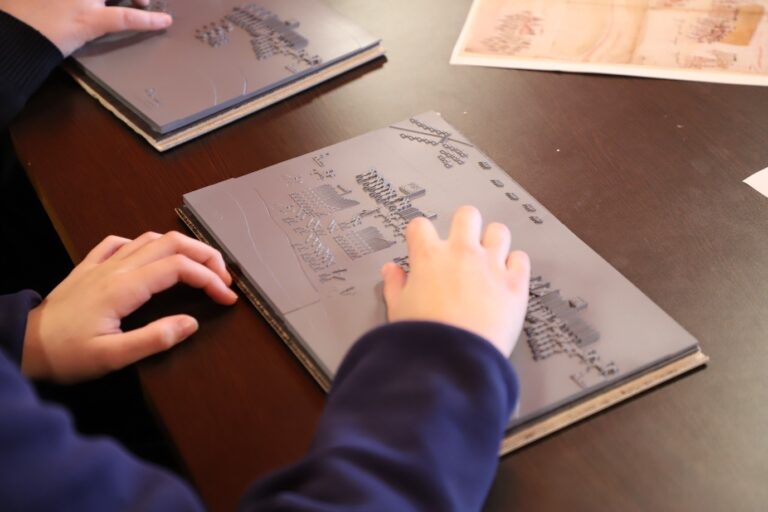
Research methods
I prioritised research through talking to and collaborating with others. This is, firstly, because my research focused on an audience group with lived experience. Second, this is a field that relies on a variety of different technologies designed to improve accessibility. Talking to people who use and work with these technologies was one of the best ways to figure out which ones might suit my department.
This project was also marked by the mentorship embedded within the fellowship scheme. I was lucky enough to be assigned two mentors: Eleonora Gandolfi (The University of Surrey) and Anna Hvass (The University of Southampton). A project like this – with a short time span and a lot of potential avenues – can easily spiral out of control. Having mentors who could strategise with me helped keep things on track.
I spoke to many people throughout my research year, a full list of which can be found at the end of this post. I learnt about the variety of barriers that visually impaired people face in a society that is not accessible, and methods to remove or diminish those barriers.
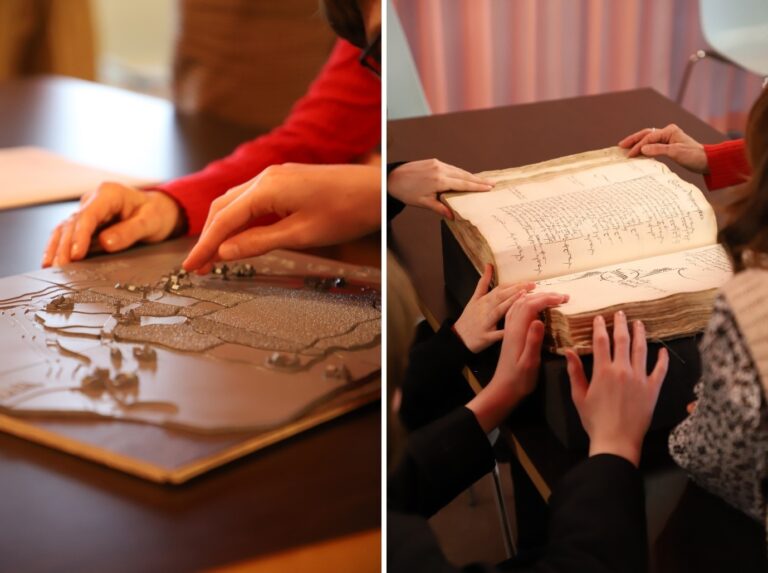
There were many practical elements that I picked up and implemented into our departmental practices during this phase of my research. For example, during my visit to the charity Southampton Sight, I was told that, if I wanted to invest in just one piece of tech, an electronic magnifier would provide the broadest use case as most visually impaired people are partially sighted and can see with magnification.
I discovered that there was an unused electronic magnifier in our Staff Reading Room. I moved it upstairs to our Education & Outreach office and was able to trial it with a partially sighted student in one of our onsite workshops. It is now permanently in use and can be requested for all our onsite workshops and events.

Sensing the Archives
Another of my goals was to trial a learning resource that was designed completely with blind and visually impaired audiences in mind. This turned into the creation of a pilot workshop called Sensing the Archives.
This workshop was designed for a group of blind and partially sighted students who came to The National Archives from New College Worcester for a full day of archival exploration. The foundation of the workshop was a collaboration I formed with George Rhodes (The University of Westminster/All Able), who is currently completing his PhD on 3D-printed tactile images at The University of Kent.
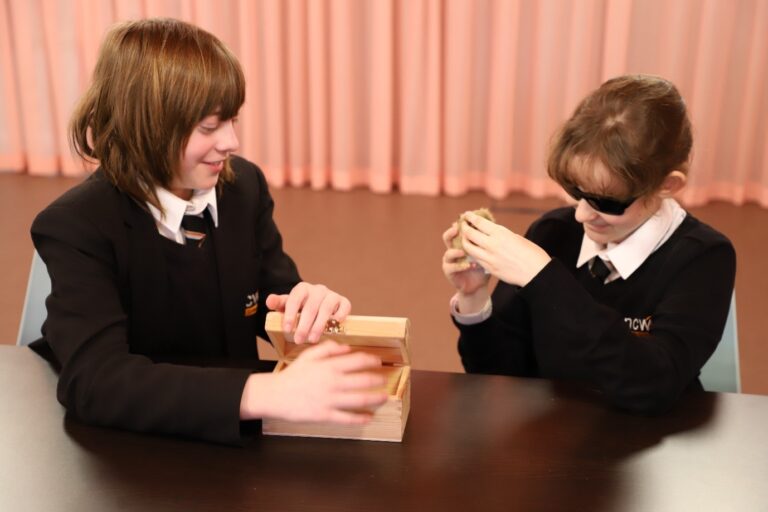
Tactile images are images that you can touch – three-dimensional relief versions of two-dimensional images and other visual representations. Since most of our documents are two-dimensional, I wanted to experiment with this as a way to make them available to visually impaired students beyond visual descriptions. With the guidance of Jeanette Normanton-Erry, Head of History at New College Worcester, George created beautiful tactile versions of our documents for the workshop.
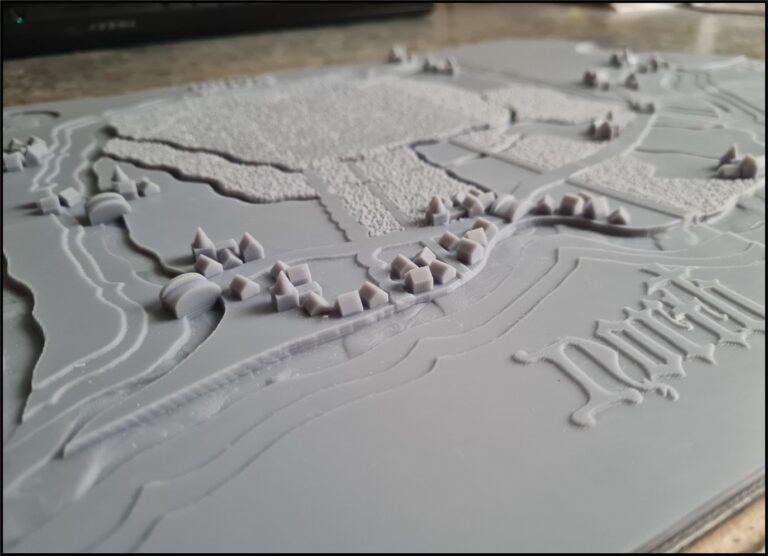
The lesson plan was designed by Hannah Carter and Rachel Hillman from Education & Outreach, in collaboration with myself and my line manager Clare Horrie. The day started with repository tours led by Alice Middlemiss and Ellie Quick. We were also advised by Kate Elizabeth Antolak, who was hired as consultant and whose insights as both a teacher and a blind Braille user were invaluable.
We focused on sensory explorations of the documents: using touch, sound, and smell. Students were introduced to the concept of archives by exploring different material samples. They also received ‘hint bags’ for each of their documents, containing objects and sound buttons that could help them figure out the context of the document. Finally, they were able to touch the original documents, as well as some special documents from our safe room touched by Elizabeth I and Henry VIII.
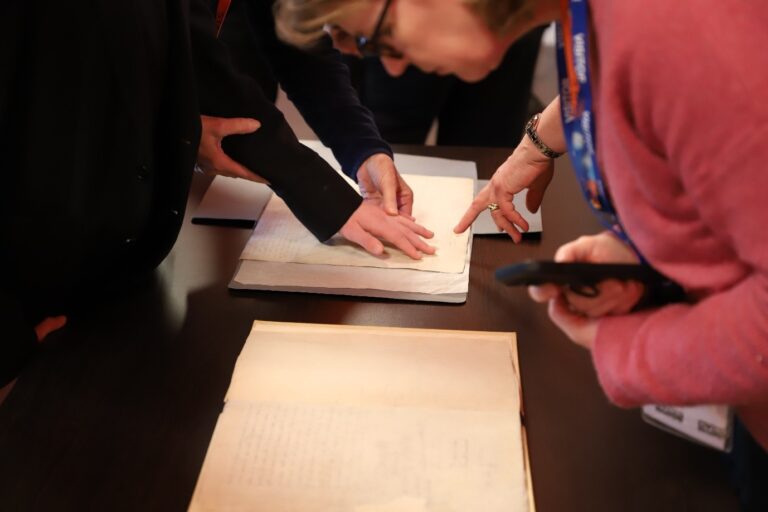
The workshop was not just educational but also fun, as borne out by the feedback from the students on the day. More in-depth feedback was also collected by some of the teachers from New College Worcester who attended. This feedback will help us further refine the workshop, and we hope to trial it with other schools and student groups so that it can keep evolving and improving.
‘I’ve been on numerous trips and I would say that that is right up at the top of all the trips I’ve been on.’
‘Much better than a history trip – we were asked to question ourselves.’
‘Awesome, interesting, really useful. Learning how archives work is important.’
Student feedback on Sensing the Archives
With this research, I have created a useful starting-off point for archives professionals who are interested in learning more about this area of accessibility and how they can practically incorporate it into their work. You can download this toolkit here: Introducing Accessibility for Visually Impaired Audiences at Archives.
I’d like to thank everyone who spoke to me as part of my research, including but not limited to:
- Kate Elizabeth Antolak
- George Rhodes from All Able
- Jeanette Normanton-Erry from New College Worcester
- Luke Beesley and Steve Graby from the Disabled People’s Archive
- Jackie Powers and Kris Gibson at Southampton Sight
- Matthew Deeprose and Nilam Chan at The University of Southampton
- Janee Hall from the Bi-Borough Inclusion Service
- Huw Alexander from textBOX
- Darren Paskell from the Thomas Pocklington Trust
- Danny Birchall
- Noel Hayden
- Representatives from the RNIB
I’d like to thank my colleagues at The National Archives for their invaluable support in implementing and testing my research, as well as my mentors Eleonora Gandolfi (The University of Surrey) and Anna Hvass (The University of Southampton) for being sources of advice and encouragement. Thank you to the organisers and Board of the Professional Research Fellowship Scheme for supporting this research project.